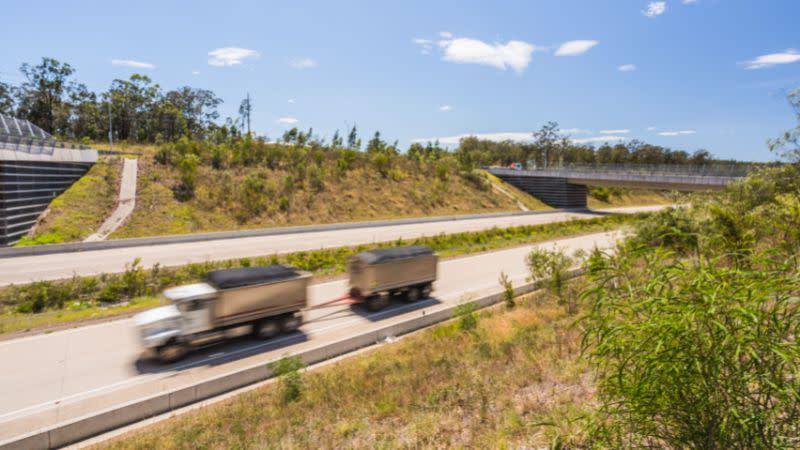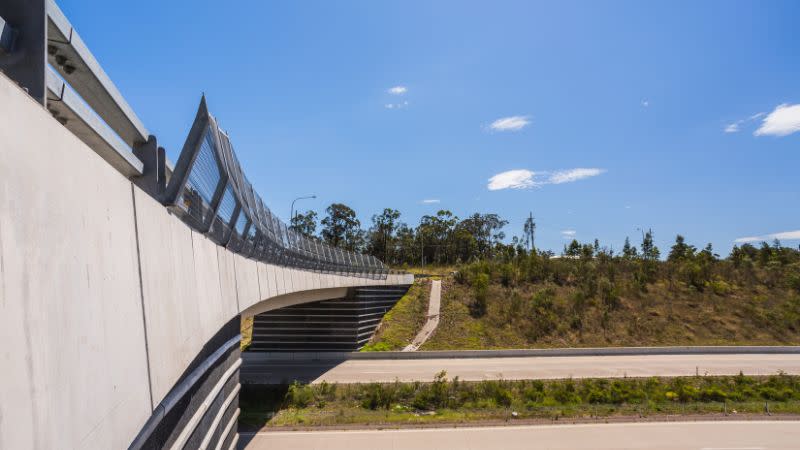Hunter Expressway Paves Way

The 40km, four-lane, dual-carriageway expressway provides a more direct and efficient route for freight movements between the Upper Hunter coal fields and the export facility of Newcastle.
At a glance
Project: Hunter Expressway
Main concrete elements:
• Plain Concrete Pavement
• Continuously Reinforced Concrete Pavement
Photographer: Ben Williams
The challenge
The Port of Newcastle is the busiest port in NSW, handling 75 per cent of the state’s international trade.
This level of heavy traffic punishment demands a pavement of superior strength and durability.
Solution and outcome
Concrete pavements were chosen for a major portion of the Hunter Expressway, which is a vital link between Newcastle and the upper Hunter River region of NSW.
Concrete pavements are renowned for their long life and low maintenance, especially when the going gets tough.
They provide a service life of 40 years under the most extreme of conditions and will do it with minimum fuss.
They are an invaluable asset to the Hunter Expressway as the main artery to the Newcastle International Port.
Export movement at Newcastle doesn’t stop and neither can its main supply artery. This is the level of dependability that’s demanded and this is the level of reliability that concrete pavements deliver.
The Hunter Expressway project was complex and large, and was divided into two sections for contract. The eastern section was 13km long and was designed and constructed by the Hunter Expressway Alliance, consisting of Roads and Maritime Services of NSW, Thiess Pty Ltd, Parsons Brinckerfhoff and Hyder Consulting.
The western section was 27km long and, as a design and construct contract, was completed by Abigroup Contractors Pty Ltd.
The total value of the project was $1.7 billion with the Federal Government providing almost 90 per cent of the funding.

The project is one of the biggest in the Hunter Region and, as it traverses significant environmentally important areas, it was built to strict environmental standards.
As a challenging project, concrete provided the solution.
Varying foundation support conditions required a variety of pavement solutions and consequently plain and continuously reinforced varieties of concrete pavement were used in different job sections.
The first form was a plain concrete pavement consisting of a 280mm thick 35 MPa base constructed over a 150mm thick 5 MPa sub-base.
The second form was a continuously reinforced concrete pavement consisting of a 250mm thick 35 MPa base constructed again over a 150mm thick 5 MPa sub-base.
In both cases the base was debonded from the sub-base with a 7mm spray seal over a wax curing compound.
The plain concrete pavement contains no steel reinforcement and utilises a system of transverse and longitudinal jointing to manage cracking behaviour.
The continuously reinforced concrete pavement has continuous longitudinal reinforcing steel consisting of N16 bars at 120mm centres, with the transverse steel consisting of N16 bars at 400mm spacing.
An interesting initiative that was undertaken on some of the concrete pavements in the Hunter Expressway is a surface treatment called diamond grinding.
In this process, small-width longitudinal grooves are cut into the surface after the concrete has hardened.
This process delivers a road-surface texture that produces a smoother vehicle ride with increased traffic traction and lower perceptible traffic noise, providing a world-class road-surface texture.
With the innate strength and durability of concrete, this world-class pavement is there for keeps.
Using concrete as the actual trafficable road surface holds considerable benefit and advantage in terms of the low cost of annual maintenance.

Concrete is a strong, robust and durable material that resists erosion and deterioration under the rigorous and demanding punishment of traffic.
Concrete pavements durability and strength reduce the need for extensive maintenance and rehabilitation of road surfacing, giving a benefit to the road network and a saving to the taxpayer.
Additionally, concrete pavements allow a road network manager respite from the never-ending and ever-increasing road-maintenance burden, allowing greater control over pavement system management.
Concrete pavements—having less repair requirements—need less repair downtime, which improves traffic access and flow and gives a superior service to the traffic network.
The Hunter Expressway, as a valuable gateway to the important export city of Newcastle, requires a dependable and reliable pavement.
Concrete pavements provide that dependability and reliability, producing a motorway that performs and lasts under extreme conditions.
When strength, durability and performance are required concrete pavements are the answer.
Benefits of using concrete:
• Low maintenance costs
• Durability and strength
• Resistant to erosion and deterioration
The Urban Developer is proud to partner with Cement Concrete and Aggregates Australia to deliver this article to you. In doing so, we can continue to publish our daily news, information, insights and opinion to you, our valued readers.














